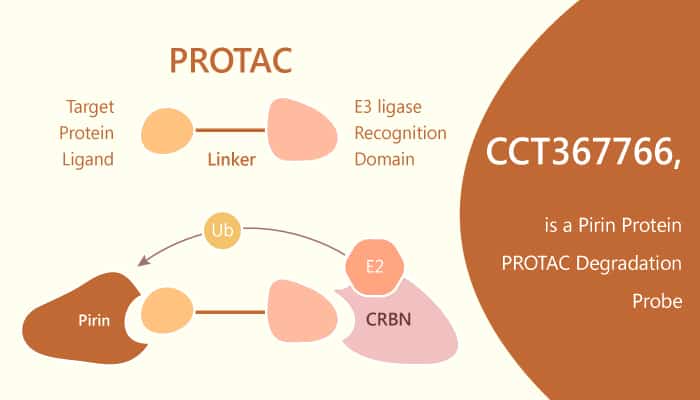Proteolysis targeting chimeras (PROTACs) are heterobifunctional molecules. It induces rapid and selective protein degradation, via the proteasome. PROTACs contain two different ligands connected by a linker, one portion of the molecule engages the target protein. While the other, attach via a flexible linker, recruits an E3 ubiquitin ligase to ubiquitinate the target.
Protein degradation probe (PDP) is a kind of PROTAC. The structure, length, and physicochemical properties are all important for protein degradation probe PDP activity. The linker controls the formation of the essential ternary complex. Additionally, linkers can stabilize the protein-protein interaction (PPI) between the target and the E3 ligase and the E3 ligase.
CCT367766 is a potent and the third generation heterobifunctional Pirin-targeting protein degradation probe (PDP).

When the third-generation probe compares to the prior probes, it retains acceptable lipophilicity. Besides, it displays a 4.2-fold increase in affinity for the recombinant Pirin compared to the second generation PDP 10, and It has a comparable affinity for CRBN.
In SK-OV-3 human ovarian cancer cells, PDP 16 application varies from 50 to 1500 nM for up to 24 h. As a result, CCT367766 demonstrates the depletion of Pirin protein as a time-dependent hook-effect.
Nextly, in whole proteome mass spectrometry. After treating SK-OV-3 cells with 50 nM CCT367766 for 4 h, the cellular selectivity of the Pirin-targeting PDP 16 is identified. The Pirin shows a significant difference refers to protein expression.
lastly, Pre-treatment SK-OV-3 cells with 10 μM thalidomide. thalidomide is a CRBN-binding competitive ligand. Then, CCT367766 successfully rescues Pirin depletion. Before CCT367766 application, chlorobisamide 22 shows a high affinity for recombinant Pirin with a KD value of 21 nM. However, CCT367766 can completely rescue chlorobisamide 22-induced Pirin expression.
In conclusion, PDPs are target engagement probes, rapid development and validation for PDPs are essential and necessary. Efficient and successful PDP design is still on the way. In this article, a selective degradation probe, CCT367766, that quickly eliminates the Pirin at low concentration. This probe provides a potential chemical tool to furtherly study a largely unexplored protein.
Reference:
[1]. Chessum NEA, et al. J Med Chem. 2018 Feb 8;61(3):918-933.